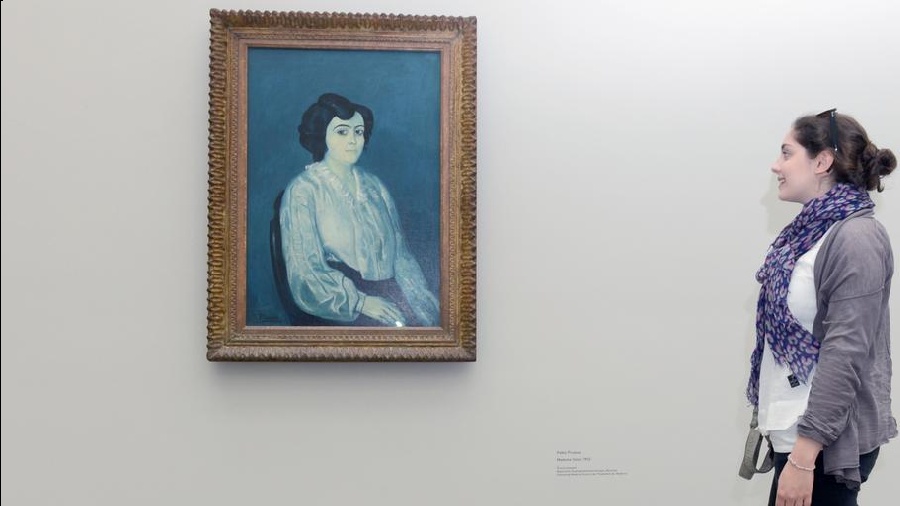Madame Soler's gaze is grave, alert and focused. This intense look was how painter Pablo Picasso captured the wife of his friend, tailor Benet Soler, in 1903.
The portrait from Picasso's Blue Period has since become the subject of a protracted and bitter dispute between the heirs of Jewish banker and art collector Paul von Mendelssohn-Bartholdy (1875-1935) and the Bavarian State Painting Collections. Both sides claim rightful ownership of "Madame Soler."
The Bavarian State Painting Collections is the custodian of a large part of the public art collections belonging to the Free State of Bavaria, as well as the Bavarian museums and public art galleries in which these artworks are exhibited.
Tug-of-war over Picasso painting
The dispute over "Madame Soler" is complicated because the parties disagree on whether the painting was sold under duress — in the context of the persecution and dispossession of Jews in Nazi Germany starting in 1933. Yet, there is no conclusive evidence to this end.
Since it is not possible in Germany to legally sue for statute-barred restitution claims — and because US courts have denied jurisdiction — the dispute over "Madame Soler" has reached an impasse. Public pressure is being used to break this deadlock.
Yet there is one possible recourse in Germany in such cases: the Limbach Commission. Set up in 2003 by the German government, the commission can be called upon to mediate in disputes involving the restitution of Nazi-looted art, especially from persecuted Jewish citizens during the Third Reich, now held by museums, libraries, archives, or other public institutions in Germany. It can then review the case and make legally non-binding — though morally no-less important — recommendations to settle the dispute.
The disputing parties must both agree to the Commission reviewing their case, however. The Bavarian State Painting Collections has shown itself unwilling to take this step.
'Madame Soler': Provenance timeline
Together with his first wife, Paul von Mendelssohn-Bartholdy amassed a considerable private collection of modern artists in Berlin, which may have included Picasso's "Madame Soler" from as early as 1913/14, but at the latest from 1930.
In 1934, however, the manager of the Lucerne branch of the Justin K. Thannhauser art dealership noted there was evidence of intention to sell. Thannhauser, himself a Jew, had helped to establish the painter's worldwide fame with his major Picasso exhibition in Munich in 1913.
Mendelssohn-Bartholdy died of a heart attack on May 11, 1935, and his second wife became his heir.
In August 1935, "Madame Soler" was listed by the Thannhauser Gallery in Berlin as "purchased."
In October 1935, Thannhauser offered the painting for sale, along with four other works by Picasso. But he himself came under increasing pressure in Nazi Germany, went to Paris and fled from there in 1940 — with many unframed works in his luggage — to the USA.
"Madame Soler" henceforth became part of Thannhauser's private collection in New York — prominently placed and clearly visible to guests.
In November 1964, the Bavarian State Painting Collections acquired Picasso's "Madame Soler" for 1.7 million Swiss francs (1.6 million Deutschmarks) from Justin Thannhauser through a company based in Vaduz, Liechtenstein.
Is it Nazi-looted art?
The Mendelssohn-Bartholdy heirs doubt that the painting was sold without pressure being put on their ancestor, or even that it was sold at all. Apart from the internal documentation of the Thannhauser Gallery, there is no direct evidence of the purchase itself. It is therefore also possible that the painting was only sold on commission by Thannhauser. Thus argues Julius H. Schoeps, historian, holder of the Federal Cross of Merit and descendant of Mendelssohn-Bartholdy — not only in the statement of claim, but also in his book "Who owns Picasso's Madame Soler?" published in 2022.
He considers it probable that Mendelssohn-Bartholdy gave the paintings to Thannhauser on commission, in order to find a buyer before they were confiscated by the Nazi authorities. He had not sold a single painting before, but between 1933 and 1935 he sold 15 of his paintings. The Free State of Bavaria, however, maintains that the painting "does not constitute cultural property seized by the Nazis."
What now?
In the case of the four other Picasso paintings that were sold, the heirs have reached settlements with the Guggenheim Museum, the Museum of Modern Art in New York, and with the Andrew Lloyd Webber Foundation. In each case, the works have remained in the collections in exchange for the payment of an undisclosed sum of money. The National Gallery in Boston returned its Picasso to the heirs.
Since it does not currently look as if a restitution law will be introduced in Germany soon, or that the Limbach Commission processes will be reformed to allow a right of appeal, even unilaterally, the only recourse left is public debate.
Of course, the Bavarian State Painting Collections may continue to maintain its position in a bid to sit out the controversy over "Madame Soler." Still, the emphatic insistence of the heirs that an injustice has been done could be reason enough for the Limbach Commission to seek clarification.











